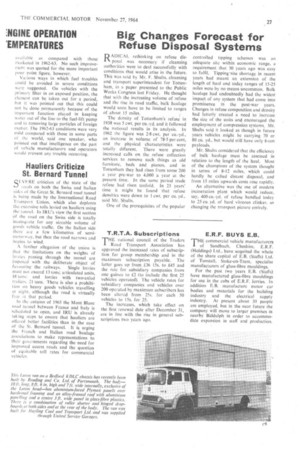Big Changes Forecast for Refuse Disposal Systems
Page 29

If you've noticed an error in this article please click here to report it so we can fix it.
ADIC.AL, rethinking on refuse dis posal was necessary if cleansing authorities were to deal successfully with conditions that would arise in the future. This was said by Mr. F. Shults, cleansing and transport superintendent for Tottenham, in a paper presented to the Public Works Congress last Friday. He thought that with the increasing volume of refuse and the rise in road traffic, bulk haulage would soon have to be limited to ranges of about 15 miles.
The density of Tottenham's refuse in 1938 was 5 cwt. per cu.-yd. and it followed the national results in its analysis. In 1962 the figure was 2.8 cwt. per cu.-yd., an increase in volume of 78-5 per cent, and the physical characteristics were totally different. There were greatly increased calls on the refuse collection services to remove such things as old furniture. beds and pianos, and in Tottenham they had risen from some 200 a year pre-war to 4,000 a year at the present time. In the same period trade refuse had risen tenfold, In 25 years' time it might be found that refuse densities were down to 1 cwt. per cu. yd., said Mr. Shults, One of the prerequisites of the popular controlled tipping schemes was an adequate site within economic range, a requirement that 30 years ago was easy to fulfil. Tipping site shortage in recent years had meant an extension of the length of haul and today ranges of 15-25 miles were by no means uncommon. Bulk haulage had undoubtedly had the widest impact of any system that had come into prominence in the post-war years. Changes in refuse composition and density had latterly created a need to increase the size of the units and encouraged the employment of compression systems. Mr. Shults said it looked as though in future years vehicles might be carrying 70 or 80 cu. yd., but would still have only 8-ton payloads.
Mr. Shults considered that the efficiency of bulk haulage must he assessed in relation to the length of the haul. Most of the champions of the system thought in terms of 8-12 miles, which could hardly be called distant disposal, and from 15 miles upwards costs rose rapidly.
An alternative was the use of modern incineration plant which would reduce, say. 400 cu.-yd. of refuse handled today to 25 cu. yd. of hard vitreous clinker. so changing the transport picture entirely.
















































































































